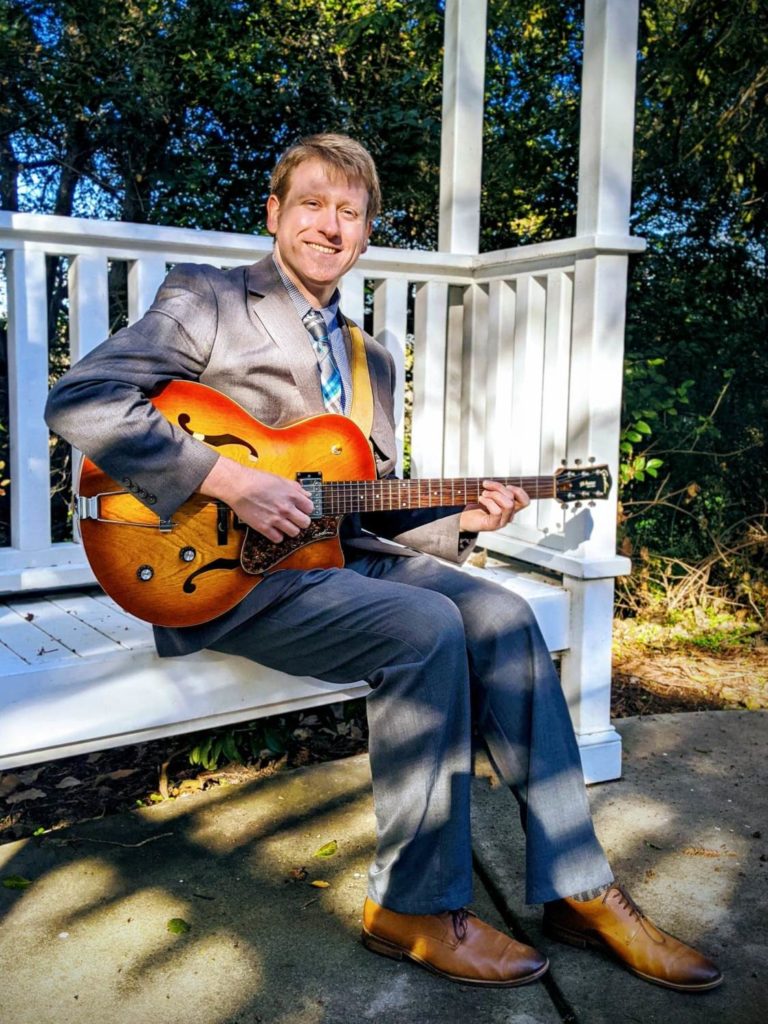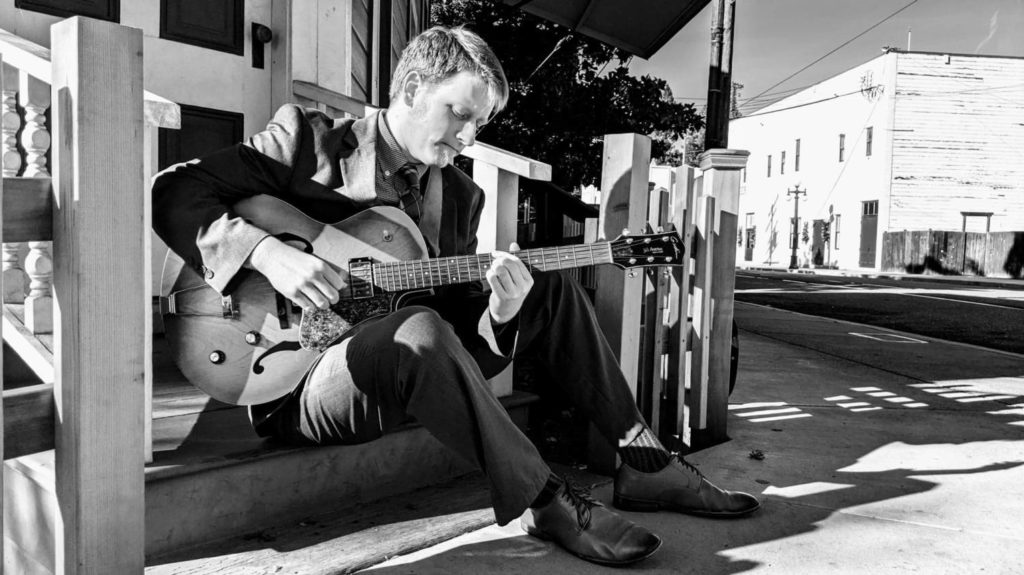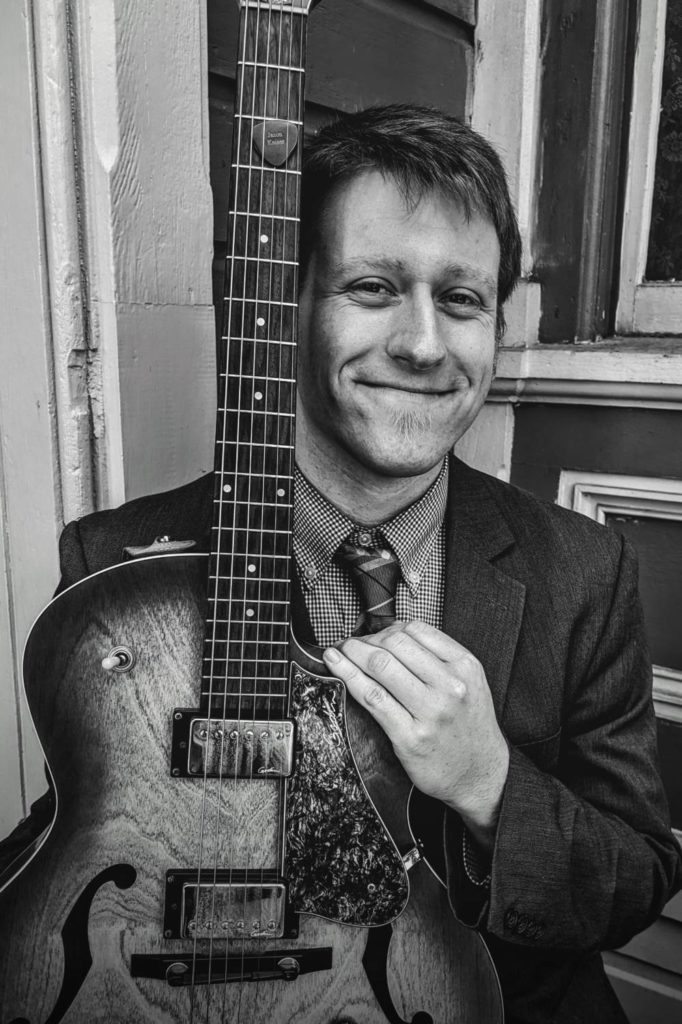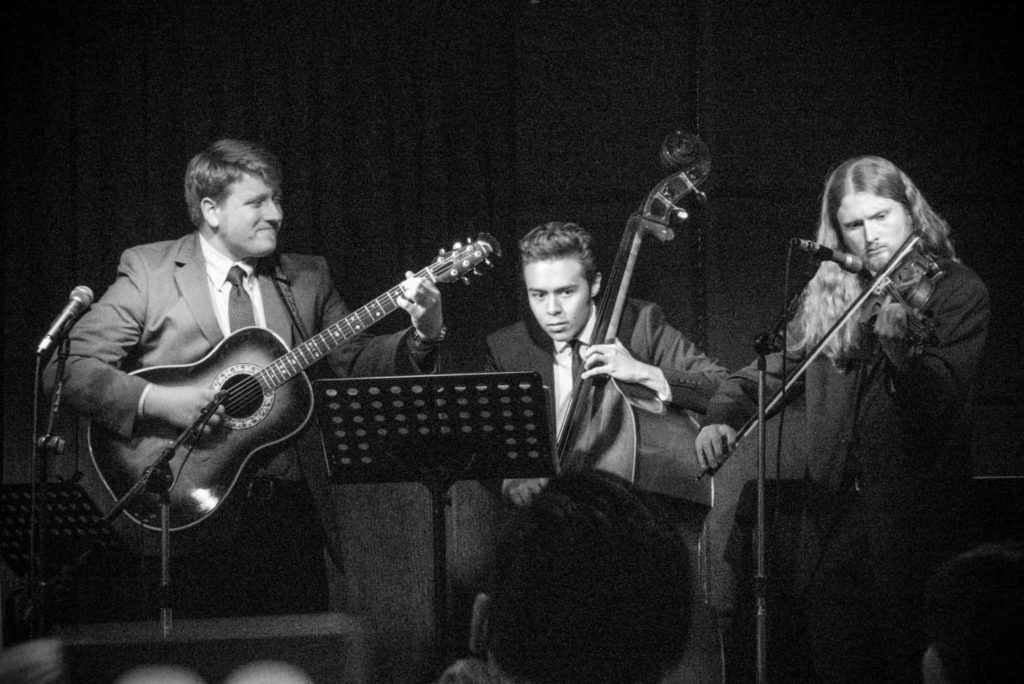Today we’ve got multi-instrumentalist Jason Keiser here to tell us a little bit about his music and his story. Jason, if you don’t mind, introduce yourself to our readers.
Hey Jed. Thanks for having me on AcoustiCult! I am Jason Keiser, a guitarist, multi-instrumentalist and music educator. Currently, I am based in San Jose, California where I perform throughout the Bay Area, teach, and am one semester away from completing my Masters in Jazz Studies degree from San Jose State University.
JED: Man I bet that feels great to be so close to the end of such an accomplishment!
It has been a wild ride, I have thoroughly enjoyed my time in my Masters but am definitely looking forward to being done!
JED: Tell us a little bit about your beginnings. Your origin story, so to speak. How did you get into music, and what made you choose this path over others?
That is interesting to think about, it has been about 10 years since I began playing and the time has sure flown! My older sister Krisanne began playing the guitar years before I did and was a huge influence on me. I remember listening to her practice from her room on tunes from Pink Floyd and Dream Theater. There was a moment where I was just like “hey, I want to try that out and do that.”
Little by little, this is how I got into playing the guitar. Krisanne had an old, off-brand strat that she used, and my Nana had an old classical nylon string guitar. As soon as I could, I began toying around on both guitars. I started to teach myself chords, and figure out how the strings worked.
For about a year or more, I was self-taught. I just learned things by ear like Creedence Clearwater Revival’s “Proud Mary.” The next logical step in being able to learn more and get direct feedback was to begin guitar lessons with an instructor.
Before I actually began playing the guitar, I was always very fortunate to be around music that my grandparents and parents listened to. My Dad was especially influential in getting me interested in listening to music and showing me a multitude of styles, genres, and some of his favorites from his music collection. I have fond memories of being a young kid listening to The Blues Brothers, John Lee Hooker, The Cure, Bruce Springsteen (his favorite!) and many more bands, artists, and genres.

Around my second year of high school I found out there was a music program at Leland High (SJ CA) with a jazz band looking for guitarists to audition. This was a very pivotal moment for me, as I began pursuing an interest in jazz music which still continues today. My high school music teacher Rian Rodriguez influenced and inspired me to always be better as a musician. He showed me how to make music with people together as an ensemble. That made a lasting impact on me!
About a year or so after getting into the high school jazz combo, my grandpa gave me a banjo. This is how I got into bluegrass music. I began teaching myself how to play the banjo, and I specifically remember people asking me to learn the tune from “Deliverance.” I had already been learning open tunings on the guitar like Open G and D, so the banjo wasn’t that far off in positions, string similarity and tuning.
Looking back, I was at this point heavily into jazz music and trying to improvise even if I didn’t really know what I was doing. I was drawn to bluegrass music because like jazz there were chord changes, (that were sometimes easier to navigate) and the possibility of improvising over them while still trying to maintain solid technique and creativity. Bluegrass music challenged me in a way that jazz didn’t, I had to be aware of my timing, tone, phrasing and still try to be musical. To me, I started to realize many connections between the genres: harmony, melody, accompaniment, improvisation!
While getting more into bluegrass with the banjo I had found out that one of my old friends in our jazz combo had an old mandolin he didn’t use. I asked to borrow it, and really never gave it back! The rest is history really… In 2013, I began my studies in jazz at West Valley Community College in Saratoga CA.
After three years of community college and playing mostly jazz gigs I was musically inclined to do something different and was looking elsewhere. In 2016, I moved to East Tennessee to study Bluegrass, Old-Time, and Country Music studies at East Tennessee State University and more so, to study under Wyatt Rice to learn New Acoustic and Spacegrass music.
Studying at ETSU was such a blast. I met, and worked with so many amazing students, colleagues, and learned from so many teachers and mentors. I have many fond memories of my time spent there. With Wyatt Rice, I was very fortunate to do a few recording sessions as a guitar duo. There is some great music in the can I hope to release soon that features Wyatt on beautiful jazz standards!
In May of 2018, I graduated from ETSU and moved back to San Jose to pursue my Masters in Jazz Studies at San Jose State University on a jazz guitar scholarship.
JED: What are your favorite 5 albums, and do they influence your work? If so, in what ways?
Currently, I am into multiple styles/idioms and listening to a multitude of music(s). Over time, my interests have changed but here are some of my favorites in no particular order.
As a bluegrass musician, if I had to pick a bluegrass record I have had on repeat lately it would have to be Larry Rice’s record “Time Machine” from 1987. I am a huge fan of Larry’s mandolin work and composing. The comping, improvisation as well as tone, technique, and feel from all the musicians on that record is unreal and grooving. The instrumental tune that really stands out in my mind is the Larry Rice composition “Spring Fever”. The A section melody is about as fast & complex sounding as a bebop head by Charlie Parker. The B section goes into this suspended modal jazz harmony and it’s my favorite tune on the record!
The second record I have had on repeat is the modal jazz masterpiece “Unity” by Larry Young, released in 1965. This record speaks to me on many levels and features some of my favorite improvisational interplay between tenor saxophonist Joe Henderson, trumpeter Woody Shaw, organist and bandleader Larry Young, and drummer Elvin Jones. Every tune on this record swings super hard, and the improvisational ideas going on in the studio is out of this world. It also features two of my favorite Shaw compositions, “The Moontrane” which has a wicked set of chord changes, and “Beyond All Limits.” If you want to transcribe some wicked “out,” linear, jazz vocab, check this record out!

The 3rd record that has made a big impact on me is Septeto Nacional de Ignacio Piñeiro’s “Soneros de Cuba” released in 2000. I have (even without always being fully aware of it) been interested in salsa, son, and latin jazz idioms. I was first introduced to this group by my high school jazz band teacher who gave me this album, and I haven’t stopped listening to them since. This is traditional cuban “son” music, and I highly recommend it!
The 4th record that has been on repeat consistently is classical mandolinist Avi Avital’s wonderful 2015 release “Vivaldi.” It features Avital throughout, in different ensembles, playing some amazing baroque music. This record was helpful for me especially because I had been preparing Vivaldi’s Mandolin Concerto in C Major: RV 425 for the last 8 months or so. The musicians capture a wide range of emotions while still reading music and that is very intriguing and inspiring to me. Having access to this wonderful music kept my drive and passion going while preparing the concerto.
The 5th record that I have been listening to for years, and can put on at anytime is The Tony Rice Unit “Backwaters,” released in 1982. There is something special about this recording, the recording quality/ acoustic sound, and everyone’s playing on this record continues to motivate me. Tony & Wyatt’s rhythmic comping, and ability to stay out of each other’s way when both playing guitar is something I try to strive for whenever playing with another guitarist or chordal instrument.
JED: You make a sharp observation about Tony’s jazz works; Wyatt’s rhythm playing is supportive but never intrusive. I’ve never thought of that in that way before man. That is some keen listening!
I remember asking Wyatt about playing rhythm on this record and it was really intriguing to hear that he would play two or 3 note voicings of a chord when Tony comped rhythm. The reasoning for this was to avoid the denseness of two guitars playing at once and thus they were able to stay out of each other’s way musically. That is fascinating to me as a jazz musician! Wyatt’s rhythm guitar playing is quite outstanding. Tony’s use of advanced picking techniques, and using the whole guitar and its range when improvising continues to blow me away. It makes me realize it is important to always practice every fret, every part of the guitar and on every string as to not be limited by anything when improvising a passage or building a musical phrase.
This album really speaks to me as both a bluegrass, jazz, and through and through improvising musician. Funny story, I had shown a colleague and friend of mine, superb jazz trumpeter Jacob Jackman this record on the way to a gig recently and he was thoroughly impressed by the jazz cover arrangements he heard, and with no drums present!
JED: Ha! That is interesting to hear.
There is a wonderful balance between Tony’s original music including “Backwaters”, “Common Ground”, “Just Some Bar in the French Quarter”, “Mobius Mambo” as well as the fine tuned wonderful acoustic arrangements of jazz standards. Tony shows his abilities as a jazz composer/arranger, and everyone in this session shows their abilities to stretch out and play superb acoustic jazz!
The musicians on this record were highly influenced by the jazz music idiom, improvisation, and specific musicians including John Coltrane, Miles Davis, NHøP, Thad Jones, and Bill Evans. If you listen closely, you can hear those influences through their improvisation, comping, and creative interplay.
This record continues to show me that bluegrass and jazz music can not only meet in the middle, but be integrated creatively, arranged, and improvised upon while still maintaining the wonderful timing, ornaments, tone, and musical elements present in both genres.
JED : Which part of your music career do you enjoy the most – live performance, recording, writing, etc.?
I enjoy every part of my music career which at this point includes teaching, recording, live performance, and composing.
I would say it is hard to choose one that is my favorite although if I had to choose it would have to be live performances at this point. There is something special about being in the moment with yourself when performing solo, or when you are with your colleagues performing, communicating, and sharing the musical experience together. Whether I am playing jazz, latin, bluegrass, or classical music this experience always gives me that exciting adrenaline rush, and it never ceases to amaze me. Lately I have been trying to write more original music which is quite a challenge for me. Sometimes I have too many ideas and can’t seem to fit them into one piece of music! Maybe it is the improvisation side of music I am so used to, where I am more comfortable arranging and making decisions on the fly, rather than saying “this is the melody, and the song is this.”
JED: What are three musicians today do you think are underrated or deserve more notoriety for their art?
That is another hard question to answer! I have worked, am studying under, collaborating, and working with so many wonderful musicians today. They all deserve more notoriety for their art, craft, and ability to play with “the blood” as Gael Garcia Bernal’s character “Rodrigo” calls it in the TV show “Mozart from the Jungle.” I want to mention three dear friends and colleagues of mine.
In no particular order, Rodrigo Ruiz, Alonso Sanchez, and Melissa Garay.
When Rodrigo Ruiz picks up the double bass, whether he plays arco or pizzicato, I know it is definitely him I am listening to. His ability to listen, and communicate a wide array of emotion with superb technical facility and feeling through music is nearly unmatched.
The same could be said for Alonso Sanchez, who continues to blow my mind musically and literally when he picks up the double bass! From 1st to thumb position, Alonso walks bass lines and plays pizzicato technique with such passion, presence, and swift improvisational attack that it always leaves you wanting more.
Vocalist Melissa Garay not only has the facility and wide range through her vocal technique, but a unique timbre, tone, and improvisational facility that lends itself to jazz, bossa nova, bebop, blues and an even soulful Mariah Carey esque vocalise.
For all three of these musicians, I can hear them through their instruments. To me that is highly important because we are human, and should evoke our presence through our instruments. They play and sing with passion, and with commitment to the musical moment! I continue to be thoroughly inspired by all of them.
JED: Tell us a little bit about your current rig – what does your “rig” consist of? What instrument(s) do you play, pedals, mics, etc.?
Currently speaking, my rig includes my #1 choice acoustic guitar to play, a vintage 1977 sunburst Ovation model 1117 regardless of style, genre. This guitar was previously owned by my mentor Wyatt Rice, and it has such a phenomenal acoustic sound, and plays wonderfully.
When the gig changes and I am playing more jazz with a full horn and rhythm section or big band, I use my Godin 5th Ave CW Kingpin II Cognac Burst hollow body. When playing latin jazz and salsa music, I mostly use my Cuban Tres B-3455-F from Barretto Music located in Miami, Florida. This has a wicked Fishman pickup system which I like to plug and dial in directly. For classical, baroque, bluegrass and acoustic jazz mandolin, I use my Eastman A style model MD505.
Over the years, I have realized there is no better way to get the most pure and sonically superb sound captured from an acoustic instrument than using a closely placed microphone.

JED: No kidding man! I prefer a mic 10 to 1 over a pickup, I just hate having feedback issues when I’m trying to solo.
Yeah I couldn’t agree more, there is really no comparison to the sound of a mic on an instrument, but the feedback is always an issue! When playing the Ovation and Eastman, I use my Neumann KM-184 studio condenser microphone. I gig and record almost solely with this mic when playing those instruments, and do not have a pickup system for either. I prefer that sound, and have come to realize personally a pickup inside an acoustic guitar can sometimes be “tin” sounding, thin, and not as clean and fully “acoustic.”
When using any of these instruments for a gig I usually run them through my two PA systems which includes a Bose S1 Pro, and Bose L1 Compact PA System with minimal reverb, and no extra effects or pedals.
JED: I just did an interview with Oklahoma guitarist Seth Russell who spoke very highly of the S1. D’you like yours?
Yes definitely! I think the S1 is phenomenal. It has so much power, and the sound coming out of the amp is super clean. There are two channels, which gives me the ability to run a variety of different instruments through it, and its battery powered! For any small gigs and clubs this amp is my go to!
It’s interesting, regarding amps and pedals, unless I am playing a musical gig featuring heavy electric guitar that needs pedals (think “13”/“Footloose”), as a jazz guitarist I do not use any guitar pedals. That is just my preference, I want to be able to hear the clean sound of the guitar when I’m playing.
JED: If you were given an unlimited budget for an album production to record your dream album, what would it look like?
For my dream album, I would first want to make sure any of the musicians I had on the record were compensated fairly as they would be putting in their time, effort, and schedule to be apart of the production.
Having the ability for an unlimited budget would also lend itself to taking as much time in the studio as needed, which is not usually the case. Money is always a big factor, and the sessions can be rushed at times. This tends to impact the process overall.
The album would consist of a wide array of styles and genres, basically everything I am interested in playing and performing including latin jazz, bluegrass, spacegrass, jazz, and classical music!
On the record, I would include all three colleagues I mentioned above, and people I have worked with before and currently. This includes Wyatt Rice, bassist Martin Walters, pianist Jason Day, mandolinist Thomas Cassell, and banjoist Alex Genova.
I would also love to have my current professors, baritone saxophonist Dr. Aaron Lington, trumpeter Jeff Lewis, drummer Jason Lewis, and my current guitar instructor Rick Vandivier on the record. The more the merrier, it would definitely be one for the books!
JED: What is your favorite album or recording that you’ve made to date?
My favorite recording that has been released thus far is the music video sessions I did with my colleague Rodrigo Ruiz last April. We recorded three tunes that day that turned out phenomenal including an original of mine “Back in California”, bluegrass gospel tune “The Old Rugged Cross”, and Bonfá bossa nova classic “Black Orpheus”. The session was so alive, and our energy and communication as a duo was superb.
I also really enjoyed working with my colleague and professor Jason Day on our jazz duo album Conversations with Jason released in 2017. There were some great moments, such as our duo arrangement of Tony Rice’s spacegrass standard “Swing 51”! Besides that, there’s plenty of music that hasn’t been released yet that I actually dig even more. It has been a few years, and my playing has changed and improved drastically.
JED: What are you currently working on?
Currently, I am working on a few recording projects, playing in a variety of ensembles and teaching.
Specifically, in recording I am working closely within two groups including The New Acoustic and Latin Music Collective. My colleagues and I finished cutting some demos a few weeks ago for the New Acoustic Collective. These include some spacegrass, original music and an arrangement of “Gold Rush” for solo guitar.

From left to right, Jason (guitar), Alonso Sanchez (upright bass), and David Boyden (fiddle.) Photo by MK Wagner.
The Latin Music Collective is also working on some really exciting music including original works by Melissa Garay, myself, and other tunes. There is a lot of great music coming up so stay tuned!
Within performance ensembles, I am in a recently formed contemporary classical ensemble that has been very interesting and exciting to be apart of! I am playing mandolin and guitar in this ensemble. We are all looking forward to the debut performance.
When I’m not playing, I teach private and group guitar classes in San Jose and direct the beginning Jazz Ensemble class at San Jose State University while studying for my Masters in Jazz Studies.
I am now diligently preparing for my Masters Recital which will take place Sunday February 9th, 2020 at 7:30pm in the SJSU Department of Music Concert Hall. This will be my final performance in the culmination of my M.M. Jazz Studies degree at San Jose State University. I will be performing original works, jazz standards, and pieces by Jerry Douglas, Pink Martini, Buddy Emmons, and more. It should be a great evening and features many colleagues I enjoy collaborating with!
JED: Well Jason best of luck at your recital next month. It has been fun getting to hear about your experiences and your music. Thanks for taking the time to talk with us!
Thanks for having me on AcoustiCult Jed!
Check out Jason’s YouTube, Instagram, and website. Featured article photo by Morgan Brittni Sonnenfeld.
